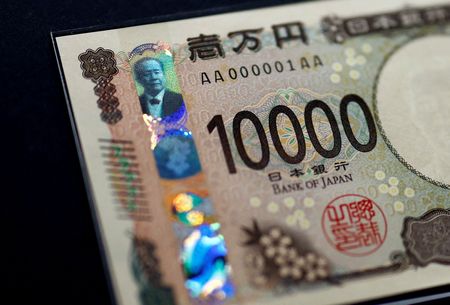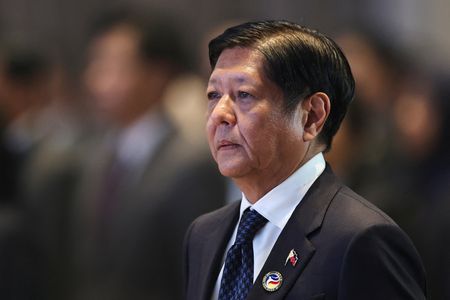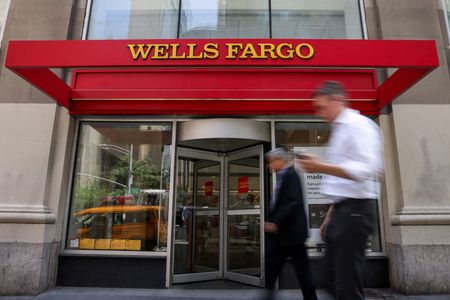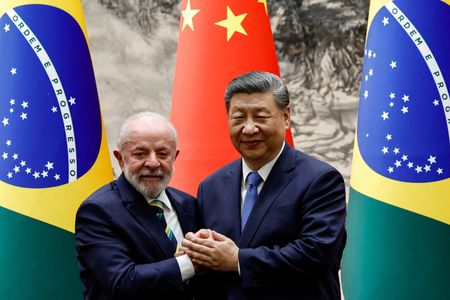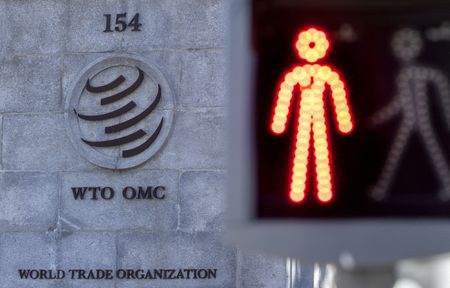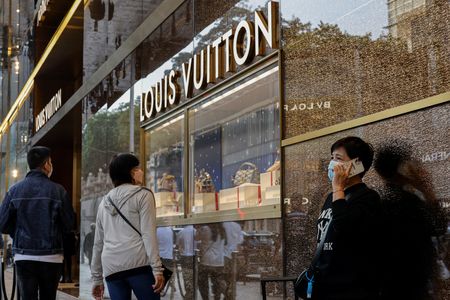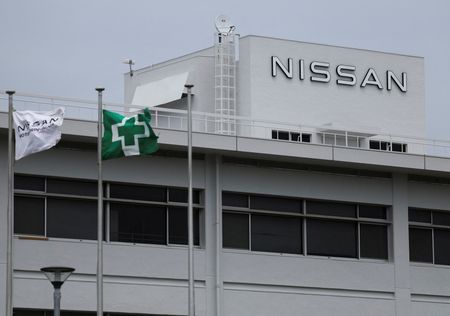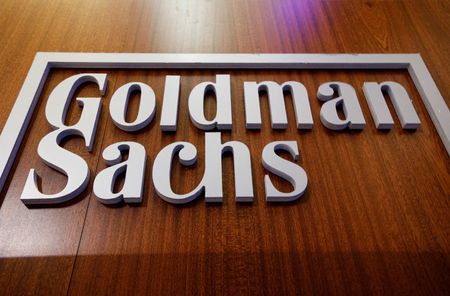By Samuel Indyk and Gertrude Chavez-Dreyfuss
LONDON/NEW YORK (Reuters) -The yen rose across the board on Monday after Japan’s ruling coalition lost its majority in the upper house, suggesting the result was mostly priced in, while investors braced for market disquiet ahead of a deadline on U.S. tariff negotiations.
Japanese markets were closed for a public holiday, leaving the yen as the main indicator of possible investor angst.
In midmorning trading, the Japanese currency gained 0.9% to 147.52 per dollar, although not far off from the 3-1/2-month low of 149.19 hit last week as investors fretted about Japan’s political and fiscal outlook.
It also nudged 0.5% higher against the euro to 172.05 and against sterling to 198.60, up 0.4%.
Prime Minister Shigeru Ishiba’s Liberal Democratic Party returned 47 seats, short of the 50 it needed to ensure a majority in Japan’s 248-seat upper chamber, where half the seats were up for grabs.
Ishiba vowed to stay on in his role even as some of his own party discussed his future and the opposition weighed a no-confidence motion.
“Since Tokyo markets were closed for Marine day today, we have to see what happens tomorrow: how the markets respond,” said Marc Chandler, chief market strategist, at Bannockburn Forex in New York.
“I know some people are saying that with the LDP party losing its majority, this could mean a shift in policy, but I don’t see it. I think people were just caught leading the wrong way on dollar/yen thinking that the election outcome was going to be a negative for the yen.”
The election result, while not entirely a shock to markets, also comes at a tricky time for a country trying to get a tariff deal with U.S. President Donald Trump before an August 1 deadline.
“Japan’s political picture has become more complicated, with investors also focusing on the U.S.-Japan tariff row,” said Roberto Mialich, global FX strategist at UniCredit.
The increased political fragility is likely to constrain the Bank of Japan’s ability to tighten monetary policy in the near term, said David Chao, global market strategist for Asia Pacific at Invesco. “It may be reluctant to add further pressure to an already volatile landscape.”
TARIFF UNCERTAINTY
Investor focus has also been firmly on Trump’s global tariff salvos, with a Financial Times report last week indicating the U.S. president was pushing for steep new tariffs on European Union products.
U.S. Commerce Secretary Howard Lutnick said on Sunday he was confident the United States can secure a trade deal with the EU, but said August 1 was a hard deadline for tariffs to kick in.
EU diplomats said the bloc was exploring a broader set of counter measures against the U.S. as prospects for an acceptable trade agreement fade, even though a negotiated solution was still their preferred option.
The euro was up 0.4% at $1.1681, while sterling last fetched $1.3488, up 0.6%. The dollar index, which measures the U.S. currency against six others, was down 0.5% at 97.969.
The European Central Bank is due to meet this week and is expected to hold rates steady after a string of cuts, while investor attention has been on whether the Federal Reserve succumbs to pressure from Trump to cut interest rates.
“We doubt ECB President Christine Lagarde will shake things up too much ahead of the central bank’s summer break, although there may be some continued concerns over recent euro strength and particularly the direction of tariffs,” said Chris Turner, ING’s global head of markets.
In the United States, Trump appeared near the point of trying to dismiss Fed Chair Jerome Powell last week, but backed off with a nod to the market disruption that would likely follow. The U.S. central bank is widely expected to hold rates steady at its July meeting.
Traders are fully pricing in a Fed rate cut by the October meeting with the odds of a second rate cut this year not fully priced in yet.
In other currencies, the New Zealand dollar gained 0.2% to US$0.5975, recovering after earlier easing following data showing consumer inflation accelerated in the second quarter but stayed below economists’ forecasts. The data led markets to raise the chance of a rate cut next month given the broader economic weakness.
Currency
bid
prices
at 21
July
02:39
p.m. GMT
Descript RIC Last U.S. Pct YTD High Low
ion Close Chang Pct Bid Bid
Previous e
Session
Dollar 97.861 98.402 -0.54 -9.80% 98.507 97.
index % 863
Euro/Dol 1.169 1.1631 0.51% 12.92% $1.169 $1.
lar 2 161
5
Dollar/Y 147.32 148.74 -0.93 -6.35% 148.51 147
en % .35
5
Euro/Yen 172.22 172.97 -0.43 5.51% 172.83 171
% .93
Dollar/S 0.7981 0.8019 -0.48 -12.07 0.8021 0.7
wiss % % 98
Sterling 1.3495 1.341 0.64% 7.91% $1.349 $1.
/Dollar 7 340
5
Dollar/C 1.3692 1.3726 -0.22 -4.76% 1.3731 1.3
anadian % 695
Aussie/D 0.6529 0.6509 0.32% 5.53% $0.653 $0.
ollar 65
Euro/Swi 0.9329 0.9317 0.13% -0.68% 0.9331 0.9
ss 314
Euro/Ste 0.866 0.8661 -0.01 4.68% 0.8673 0.8
rling % 651
NZ 0.5977 0.5961 0.29% 6.84% $0.597 0.5
Dollar/D 8 939
ollar
Dollar/N 10.1648 10.1576 0.07% -10.57 10.212 10.
orway % 9 155
5
Euro/Nor 11.8828 11.8169 0.56% 0.97% 11.892 11.
way 5 818
Dollar/S 9.5857 9.6426 -0.59 -12.99 9.6812 9.5
weden % % 864
Euro/Swe 11.2062 11.2214 -0.14 -2.27% 11.253 11.
den % 9 204
(Reporting by Gertrude Chavez-Dreyfuss in New York and Samuel Indyk in London; Additional reporting by Ankur Banerjee in Singapore; Editing by Kirsten Donovan, Rachna Uppal and Susan Fenton)

